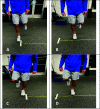CRITERION-BASED REHABILITATION PROGRAM WITH RETURN TO SPORT TESTING FOLLOWING ACL RECONSTRUCTION: A CASE SERIES
- PMID: 33344032
- PMCID: PMC7727433
- DOI: 10.26603/ijspt20201151
CRITERION-BASED REHABILITATION PROGRAM WITH RETURN TO SPORT TESTING FOLLOWING ACL RECONSTRUCTION: A CASE SERIES
Abstract
Background: Less than 50% of those sustaining an anterior cruciate ligament (ACL) injury return to their preinjury level of sports participation or participate in competitive sport at two to seven years post ACL reconstruction (ACLR). After ACLR, it has been reported that frequency of subsequent ACL tears has reached as high as 31%.
Purpose: The purpose of this case series was to evaluate return to sport and reinjury rates following the use of a criterion-based rehabilitation protocol with a final return to sport test that utilizes minimal equipment following ACL reconstruction.
Study design: Case series.
Methods: Following ACL reconstruction, participants were included if they had a goal of returning to their pre-injury sport or level of activity, were between 16 and 50 years of age at the time of evaluation, had at least 25 physical therapy visits covered by insurance, and planned to complete physical therapy until clearance for return to sport.
Results: Forty-three participants met the inclusion criteria and enrolled in the study. Twenty-one participants completed the full course of rehabilitation including passing their return to sport test and nineteen participants completed the two-year follow-up. Data obtained at two years indicated that 84% were able to return to their preinjury level of sports competition. A smaller percentage (16%) were able to return to a reduced level of sport and only one participant reported a second ACL injury.
Conclusion: Participants that completed the full course of rehabilitation and passed return to sport testing had a larger percentage that were able to return to preinjury participation levels than currently reported in the literature. This case series did not exclude participants based on graft type, single vs double bundle procedure, ACL revision surgeries, nor concomitant procedures or injuries.
Level of evidence: Level 4.
Keywords: anterior cruciate ligament; criterion-based rehabilitation; movement system; return to sport testing.
© 2020 by the Sports Physical Therapy Section.
Figures






References
-
- Gornitzky AL Lott A Yellin JL Fabricant PD Lawrence JT Ganley TJ. Sport-specific yearly risk and incidence of anterior cruciate ligament tears in high school athletes: a systematic review and meta-analysis. Am J Sports Med. 2016; 44(10): 2716-2723. - PubMed
-
- Griffin LY Agel J Albohm MJ et al. Noncontact anterior cruciate ligament injuries: risk factors and prevention strategies. J Am Acad Orthop Surg. 2000; 8(3): 141-150. - PubMed
-
- Ardern CL Taylor NF Feller JA Webster KE. Return-to-sport outcomes at 2 to 7 years after anterior cruciate ligament reconstruction surgery. Am J Sports Med. 2012; 40(1): 41-48. - PubMed
-
- Ardern CL Webster KE Taylor NF Feller JA. Return to sport following anterior cruciate ligament reconstruction surgery: a systematic review and meta-analysis of the state of play. Br J Sports Med. 2011; 45(7): 596-606. - PubMed
-
- Ardern CL Webster KE Taylor NF Feller JA. Return to the preinjury level of competitive sport after anterior cruciate ligament reconstruction surgery: two-thirds of patients have not returned by 12 months after surgery. Am J Sports Med. 2011; 39(3): 538-543. - PubMed
LinkOut - more resources
Full Text Sources
Medical
Research Materials
Miscellaneous
